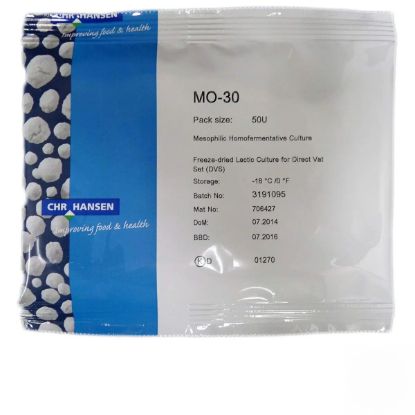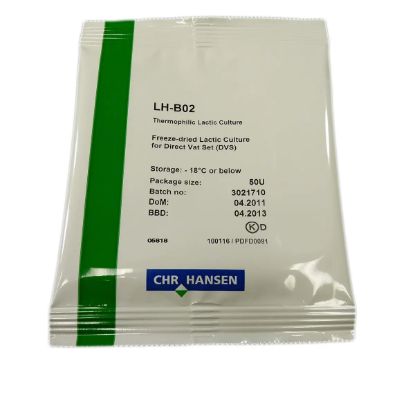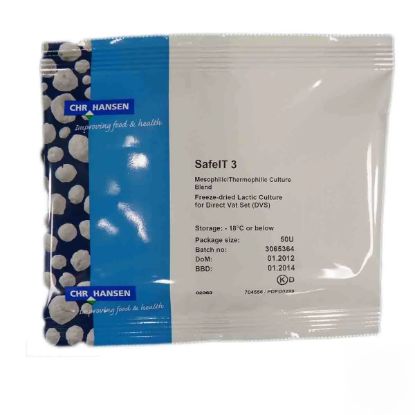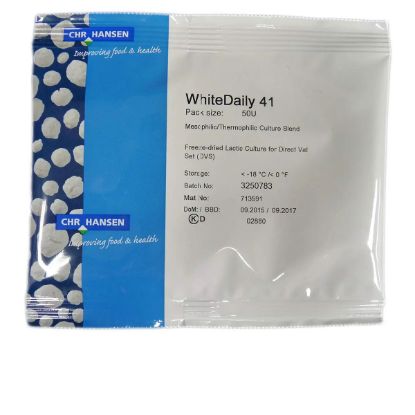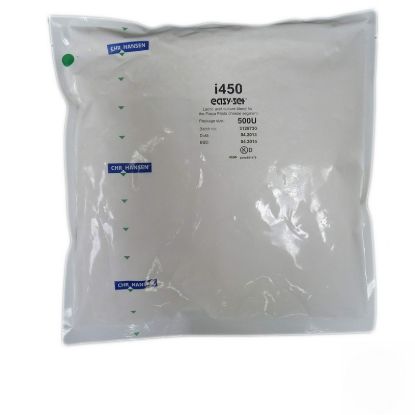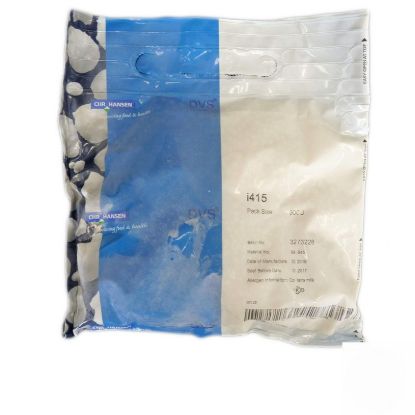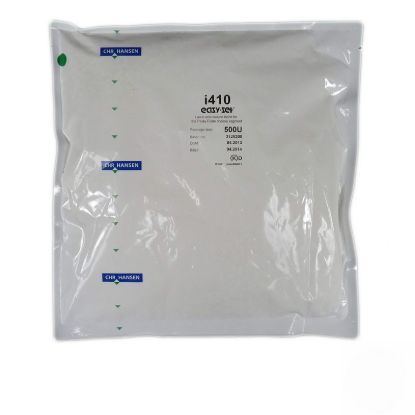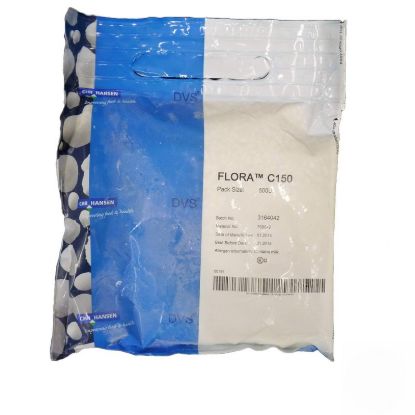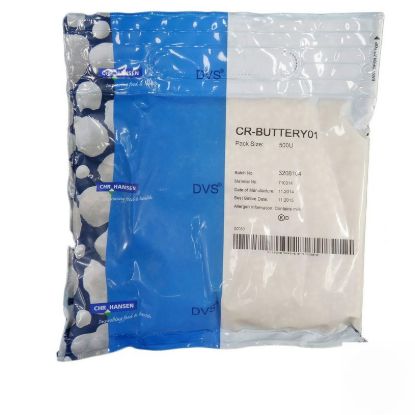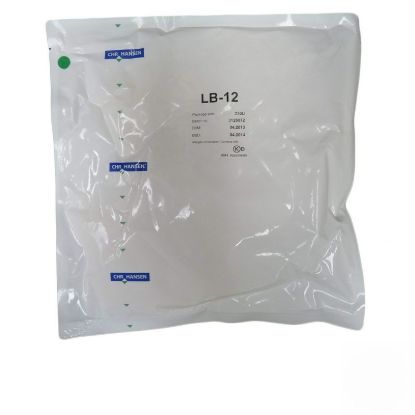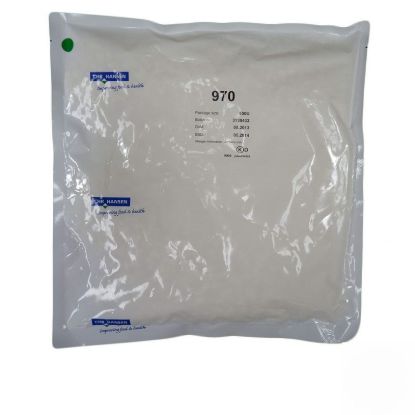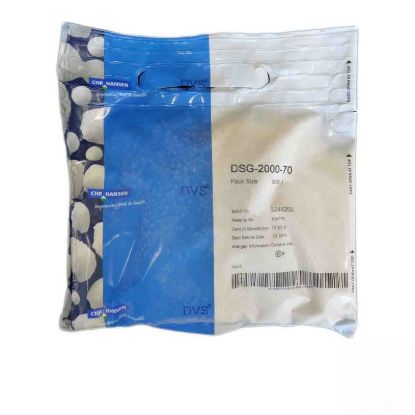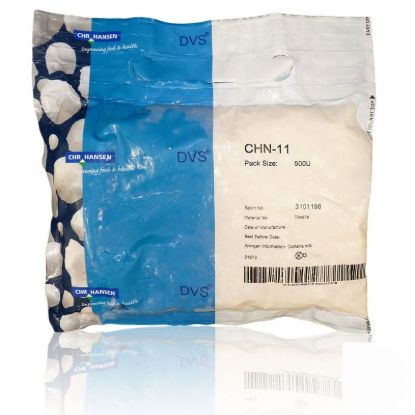Cheese Starter Cultures
Starter cultures are the first step in cheesemaking.
STI-14 Freeze-dried 50 u
Thermophilic lactic acid culture.
The culture is primarily applied in Pasta Filata cheese types e.
g Mozzarella and Pizza cheese types.
The culture can be applied alone or in combination with other lactic acid cultures, e.g. Lactobacillus delbrueckii subsp.bulgaricus and Lactobacillus helveticus.
MO-30 Freeze-dried 50 u
Mesophilic homofermentative culture, type O.
This culture contains specially selected strains chosen for their phage resistance and ability to produce lactic acid quickly.
This culture does not produce CO2.
The culture is primarily used in the manufacture of Continental cheese types with no eyes and short texture (e.g.Pecorino) and soft cheese specialties.
MO-20 Freeze-dried 50 u
Mesophilic homofermentative culture, type O.
This culture contains specially selected strains chosen for their phage resistance and ability to produce lactic acid quickly.
This culture does not produce CO2.
The culture is primarily used in the manufacture of Continental cheese types with no eyes and short texture (e.g.Pecorino) and soft cheese specialties.
LH-B02 Freeze-dried 50 u
Defined thermophilic lactic acid culture.
The culture enhances the overall flavor intensity of the cheese by accentuating important flavor notes.
The culture is primary applied in the production of Italian and Swiss cheese varieties.
The culture can be applied alone or in combination with other lactic cultures, e.g. Streptococcus thermophilus and Lactobacillus delbrueckii subsp.bulgaricus and LD culture.
RST-743 Freeze-dried 50 u
A defined strain homofermentative culture blend with improved resistance to bacteriophages.
The culture does not produce CO2.
The culture is primarily applied in the production of semi-hard, hard and very hard pressed cheeses with a closed texture and a min cooking temperature at 35°C (95°F).
Examples of applications are Cheddar, Cheshire, Colby, Monterey Jack, Munster, Fontal, Raclette & Saint Paulin.
MO-10 Freeze-dried 50 u
Mesophilic homofermentative culture, type O.
This culture contains specially selected strains chosen for their phage resistance and ability to produce lactic acid quickly.
This culture does not produce CO2.
The culture is primarily used in the manufacture of Continental cheese types with no eyes and short texture (e.g.Pecorino) and soft cheese specialties.
TCC-20 Freeze-dried 50 u
Defined thermophilic lactic acid culture.
The culture is primarily applied in the production of Pasta Filata cheese types, e.g. Mozzarella and Pizza cheese types.
STI-13 Freeze-dried 50 u
Thermophilic lactic acid culture.
The culture is primarily applied in Pasta Filata cheese types e.
g Mozzarella and Pizza cheese types.
The culture can be applied alone or in combination with other lactic acid cultures, e.g. Lactobacillus delbrueckii subsp.bulgaricus and Lactobacillus helveticus.
WhiteDaily 82 Freeze-dried 50 u
Blend of mesophilic homofermentative and thermophilic lactic acid cultures This culture contains specially selected strains chosen for their phage resistance and ability to produce lactic acid quickly.
This culture does not produce CO2.
The culture is used in the production of White Cheeses, Feta or UF products.
Depending on production process, the texture will be firm with some holes or closed.
FLORA-DANICA Freeze-dried 500 u
Mesophilic aromatic culture, type LD.
The culture produces flavor and CO2.
he culture is primarily used in the manufacture of Continental cheese types (Gouda, Edam, Leerdam, Samsoe) and soft cheese types (Lactic cheeses, Camembert, Blue cheese).
WhiteDaily 41 Freeze-dried 50 u
Homofermentative culture blend.
The culture does not produce CO2.
The culture is used in the production of White Cheeses, Feta or UF products.
Depending on production process, the texture will be firm with some holes or closed.
R-704 Freeze-dried 50 u
Mesophilic homofermentative culture, type O.
This Chr.Hansen culture range provides phage resistant defined strains for continuous Direct Vat Set (DVS) use.
This culture contains specially selected strains chosen for their phage resistance and ability to produce lactic acid quickly.
This culture does not produce CO2 .
The culture is primarily applied in the production of cheeses with a closed texture, e.g. Cheddar, Feta and Cottage cheese.
The culture can be applied in other fermented dairy products, in combination or not with other lactic cultures.
FLORA-DANICA Freeze-dried 50 u
Mesophilic aromatic culture, type LD.
The culture produces flavor and CO2.
This range provides cultures with fast acidification properties at a low inoculation rate.
The culture is primarily used in the manufacturing of Continental semi-hard cheese varieties with eyes, e.g. Gouda, Edam, Leerdam and Havarti.
ALP D Freeze-dried 100 DCU
Concentrated, freeze-dried culture for direct inoculation of process milk.
Defined multiple-species culture.
The quantities of inoculation indicated should be considered as guidelines.
Supplement cultures may be required depending on technology, fat content and product properties desired.
We do not accept any liability in case of undue application.
Easy-Set I450 Frozen 500 u
Very high active thermophilic culture blend for continous direct vat set use.
The strains are specially selected for their phage resistance and ability to produce lactic acid quickly.
The culture is primarily applied in the production of Pasta Filata cheese types, e.g. Mozzarella and Pizza cheese types.
Easy-Set I415 Frozen 500 u
Very high active thermophilic culture blend for continous direct vat set use.
The strains are specially selected for their phage resistance and ability to produce lactic acid quickly.
Easy-Set I410 Frozen 500 u
Very high active thermophilic culture blend for continous direct vat set use.
The strains are specially selected for their phage resistance and ability to produce lactic acid quickly.
Easy-Set FLORA C150 Frozen 500 u
This Chr.Hansen EASY-SET® FLORA™ culture blend is for continuous direct vat set use at low inoculation rates.
The culture contains multiple, but well defined mesophilic homofermentative strains, type O.
The strains are carefully selected for their mild flavor contribution, high phage resistance and ability to produce lactic acid quickly.
The culture does not contribute to eye formation in the cheese.
The cultures are primarily used in the manufacture of Continental cheese types with no requirement for eye formation (Edam, Gouda, Danbo).
Easy-Set A3040 Frozen 1000 u
This Chr.Hansen EASY-SET® culture contains defined mesophilic and thermophilic strains and is for continous direct vat set use.
The strains are carefully composed to provide fast lactic acid production, extreme phage robustness and traditional (mesophilic) Cheddar flavor and texture development without any CO2 production (homofermentative).
The EASY-SET® A3000 program provides an unparallelled performance consistency between culture rotations.
CR-BUTTERY 01 Frozen 500 u
A defined adjunct culture blend which enhances the overall flavor intensity of the cheese by accentuating important flavor notes.
It enhances the balanced, mellow, rounded and clean flavors and suppresses unwanted flavors like sour, bitter and flat.
The culture contains a nisin producing strain for promotion of bacteria lysis.
LB-12 Frozen 250 u
Defined thermophilic lactic acid culture.
The culture is primarily applied in the production of yoghurt and other fermented milk products.
The culture is normally applied in combination with Yo-Flex® or nu-trish®The culture can also be used in production of Italian cheese varieties together with other lactic cultures e.g. Streptococcus thermophilus.
cultures.
The culture can also be used in production of Italian cheese varieties together with other lactic cultures e.g. Streptococcus thermophilus.
DVS-970 Frozen 500 u
This Chr.Hansen DVS® culture contains defined mesophilic strains and is for continous direct vat set use.
The culture does not produce CO2 (homofermentative).
The culture is primarily applied in the production of cheeses with a closed texture, e.g. Cheddar, Feta and Cottage cheese.
The culture can be applied in other fermented dairy products, in combination or not with other lactic cultures.
CR-MATURE 01 Frozen 500 u
A defined adjunct culture blend which enhances the overall flavor intensity of the cheese by accentuating important flavor notes.
It enhances the balanced, mellow, rounded and clean flavors and suppresses unwanted flavors like sour, bitter and flat.
The culture contains a nisin producing strain for promotion of bacteria lysis.
Some strains are facultative heterofermentative and may produce CO2 in specific conditions.
DSG-2000-70 Frozen 500 u
Mesophilic eXact® culture, type L.
The culture produces diacetyl flavor and a medium level of CO2.
DSG 2000 cultures can be used in any cultured dairy product where a balanced acid and diacetyl flavor is desired.
These cultures are formulated to produce a shorter make time without compromising flavor.
CHN-11 Frozen 500 u
Mesophilic aromatic culture, type LD.
The culture produces flavor and CO2.
This range provides cultures with fast acidification properties at a low inoculation rate.
The culture is primarily used in the manufacturing of Continental semi-hard cheese varieties with eyes, e.g. Gouda, Edam, Leerdam and Havarti.



